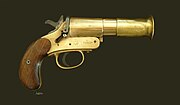
An Orion-brand single shot, breech loaded, 12 gauge flare gun. Its design is highly typical of commercially available flare guns.
A flare gun is a firearm that launches flares. It is typically used for signalling, as distress signalling, for people at sea or from the ground to aircraft. It is not designed to function as a weapon.
Types[]
The most common type of flare gun is a Very (sometimes spelled Verey[1]), which was named after Edward Wilson Very (1847–1910), an American naval officer who developed and popularized a single-shot breech-loading snub-nosed pistol that fired flares (Very flares).[citation needed] They have a single action trigger mechanism, hammer action, center fire pin.[2] Modern varieties are frequently made out of brightly colored, durable plastic.

British 1" calibre Very pistol of World War I
The older type of Very pistol, typical of the type used in the Second World War, are of one inch bore (26.5mm). These are still available and more recent longer barrel models can also fire parachute flares.[3] Many newer models fire smaller 12-gauge flares.[citation needed] In countries where possession of firearms is strictly controlled, such as the United Kingdom, the use of Very pistols as emergency equipment on boats is less common than, for example, the United States. In such locations, distress flares are more commonly fired from single-shot tube devices which are then disposed of after use. These devices are fired by twisting or striking a pad on one end, but the contents are otherwise similar to a round from a flare gun, although the flares themselves are much larger and can burn brighter for longer.[citation needed]
Flare guns may be used whenever someone needs to send a distress signal. The flares must be shot directly above, making the signal visible for a longer period of time and revealing the position of whoever is in need of help.
Use as weapons[]

A Molins No. 1, 1 inch calibre Very pistol, c1940, made by Berridge Ltd. The small stud on the barrel was for locating a barrel extension for line throwing
While not intended as a weapon, flare guns have been used as such in some situations. In 1942, a German pilot mistakenly landed at the Pembrey Airfield in Wales. The duty pilot, Sgt. Jeffreys, did not have a conventional weapon, so he grabbed a Very pistol and used it to capture the German pilot, Oberleutnant Armin Faber.[4]
Towards the end of World War I during the Final Offensive of the Sinai and Palestine Campaign, on 19 October 1918 a German aircraft was destroyed on the ground by firing a Very light into the aircraft. The D.F.W. two–seater was first seen in the air; the first German aircraft since aerial fighting over Deraa on 16 and 17 September just prior to the beginning of the Battle of Sharon. The two–seater was forced to land and was destroyed after the German pilot and observer had moved to safety.[5][6]
In World War II, Germany manufactured grenades designed to be fired from adapted flare guns known as the Kampfpistole, or Sturmpistole in its final form. The weapon was designed to function as an anti tank weapon but failed to perform to expectations due to the minuscule amount of TNT carried in the hollow charge projectiles.[7]
In the latter stages of the Korean War, on November 2 of 1951, Lieutenant Edward Mastronardi and his 28-man platoon of the Royal Canadian Regiment were occupying a spur halfway between UN and Chinese lines known as the Song-gok. During the night of the 2nd-3rd, Chinese infantry launched several attacks against the spur. During the second attack, Mastronardi personally shot two Chinese soldiers with his Inglis Hi-Power pistol, and killed a third with his flare gun.[8]
See also[]
References[]
- ↑ Chambers 21st Century Dictionary (revised ed.). New Delhi: Allied Publishers (P) Ltd.. 2005. p. 1578. ISBN 81-86062-26-2. http://books.google.co.uk/books?id=D37Cd3Ad7eIC&pg=PA1578&dq=%22Verey+light%22+%22Very+light%22&hl=en&sa=X&ei=PQL1TrjZNsaFhQenn7WoAQ&ved=0CEoQuwUwAA#v=onepage&q=%22Verey%20light%22%20%22Very%20light%22&f=false.
- ↑ *Julio S. Guzmán, Las Armas Modernas de Infantería, Abril de 1953
- ↑ Pains Wessex catalogue showing modern 26.5mm flare gun and both parachute flares (maroons) and conventional flare cartriges, accessed July 2012
- ↑ Pembrey Airport: History
- ↑ F. M. Cutlack (1941). "The Australian Flying Corps in the Western and Eastern Theatres of War, 1914–1918". Official History of Australia in the War of 1914–1918 Volume VIII. Canberra: Australian War Memorial. pp. 168–9. http://www.awm.gov.au/histories/first_world_war/volume.asp?levelID=67894.
- ↑ Falls, Cyril; A. F. Becke (maps) (1930). Military Operations Egypt & Palestine from June 1917 to the End of the War. Official History of the Great War Based on Official Documents by Direction of the Historical Section of the Committee of Imperial Defence. 2 Part II. London: HM Stationary Office. p. 466. OCLC 256950972.
- ↑ German Flare Gun
- ↑ McMillan, Duncan. "CANADA BOY, YOU DIE TONIGHT". KOREA VETERANS ASSOCIATION OF CANADA INC. http://www.kvacanada.com/stories_canadianboy.htm. Retrieved 7 June 2013.
External links[]
| Wikimedia Commons has media related to Flare guns. |
- History of the Very pistol with many examples
- WW German signal-pistol grenades and their use by tank crews.
- Firing Very Pistol, November 1942, Popular Science
The original article can be found at Flare gun and the edit history here.